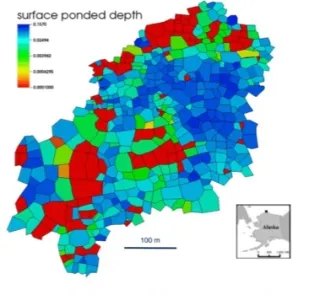Intermediate Model Overcomes Computational Costs of Simulating Thermal-Hydrology for Polygonal Landscapes
Date Published
Modeling approach improving representations of permafrost dynamics in evolving landscapes.
Objective
- Develop an intermediate-scale modeling approach to help bridge the gap between field and laboratory observations and the scale of a regional or global model grid cell.
New Science
- Enables permafrost dynamics including thaw-induced subsidence to be applied across the Arctic, thus improving representations of permafrost dynamics in evolving landscapes. Capabilities are being used to develop improved parameterizations and computational approaches for use in Earth system models.
Impact
- Leveraged fine-scale modeling tools and replaced a computationally difficult three-dimensional system with a novel multiscale model structure.
- The approach was shown to accurately approximates the fully-resolved solution but at a significantly lower computational cost.
Image with caption
Citation(s)
Funding
This research was supported by the Director, Office of Science, Office of Biological and Environmental Research of the US Department of Energy under Contract No. DE-AC02-05CH11231 as part of the Next-Generation Ecosystem Experiments (NGEE Arctic) project.


